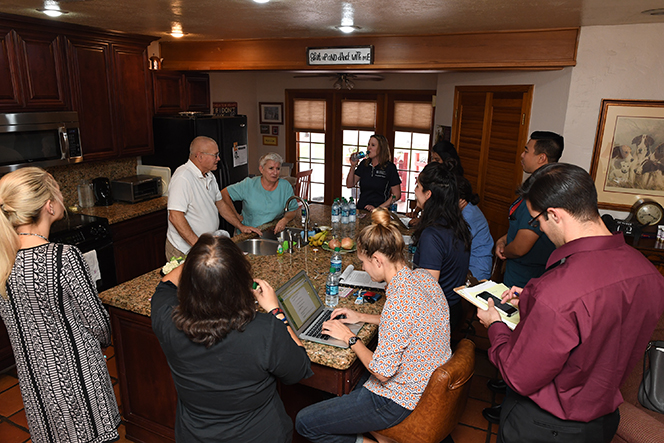A one-year inter-professional mentorship program is bringing together health profession students from Northern Arizona University and the University of Arizona College of Medicine – Phoenix to better understand and improve the patient’s experience.
The Community Health Mentor Program, which launched in 2015, stresses the importance of an inter-professional approach in order to provide successful health care.
Each spring, approximately 200 students from NAU’s Occupational Therapy and Physical Therapy programs and UA’s Doctor of Medicine program in Phoenix are placed in inter-professional teams. The teams are assigned a community health mentor—an adult volunteer with a chronic medical condition or disability.
The students participate in meetings in the mentor’s home or living facility eight times over the course of a year to discuss his/her condition, nutrition and health care experience. Students from NAU’s Physician Assistant Studies and Arizona State University’s Nutrition programs also participate in select team mentor visits. There are currently 48 teams and 60 mentors working together this year.
For the students, the program is an opportunity to learn from the mentor. Conditions of the mentors range from high blood pressure and arthritis to diabetes and Alzheimer’s, allowing the students to see how different and broad the experiences are for patients. The teams do not provide medical care but share health education and community resources.
“There’s a personal connection the students can develop. They can see how the mentor changes and how a chronic condition impacts their life in a variety of ways,” said Sarah Coles, MD, assistant professor at the University of Arizona College of Medicine – Phoenix and co-principal investigator on the project. “It’s really a great opportunity to get to know someone and develop a meaningful relationship.”
Oaklee Rogers, OTD, professor of Occupational Therapy at Northern Arizona University and co-principal investigator, added that the students often identify the mentor program as their favorite inter-professional experience because they are able to truly understand from someone else’s perspective what it’s like to live with a chronic disease or disability.
“We consider the mentors the primary teachers. They provide feedback on how to improve and be better providers,” Coles said. “It’s what health care should be, the patient is the center of the team.”
Jim and Louisa Milstead, who have been mentors for two groups, said they enjoy the experience. “It’s nice to interact with young, bright students,” Louisa said. “It’s good for the soul.”
On a recent visit to the couple’s Phoenix home, the topic was nutrition, and the Milsteads opened their cupboards and refrigerator to the students so they could see what kinds of food they keep in their home.
“I’m sure we don’t eat as well as we should,” said Louisa, who told ASU nutrition student Brenda Alvarado that she buys cereal for her grandchildren who often visit. Both the Milsteads are very active despite Jim’s longtime diabetes and Louisa’s recent minor heart attack.
Third-year medical student Arianna Kousari said she loves the program because students get to spend time getting to know their mentors, but they also work as a team with students from other health care professions and universities.
“It has been interesting to see all that goes into the other professions, like the intricacies of taking a Physical Therapy assessment,” she said.
Lindsey Kohnert, M.Ed., and a PhD candidate in Occupational Therapy at NAU, said the program has allowed her “to collaborate with and learn from peers studying in different disciplines, ones that OTs have traditionally not collaborated with in the past, especially at the collegiate level. I have had the opportunity to work with students from the PT, PA, MD and nutrition programs at NAU, UA and ASU.”
In its second year, the community health mentor program was recently recognized by the National Center for Interprofessional Education and Practice and is one of the first in Arizona to make the list.
“We are proud to be recognized at a national level,” Rogers said. “Not a lot of health profession programs have opportunities to collaborate and work together like this.”



